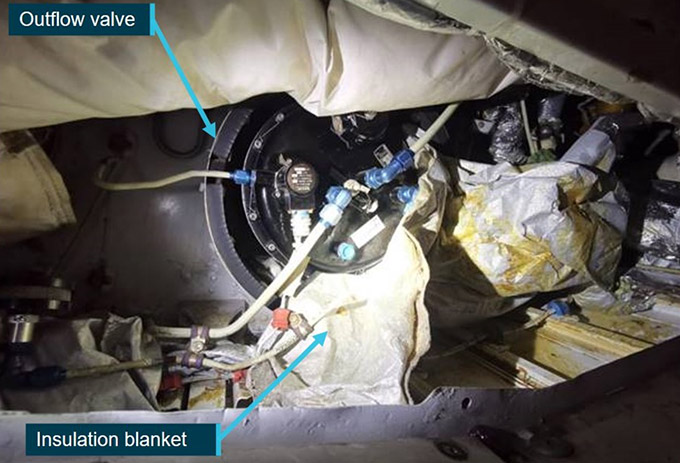
|
Key points:
|
An insulation blanket likely not correctly installed during maintenance was partially ingested by an outflow valve in a Fokker 100 airliner’s pressurisation system, resulting in the crew donning oxygen masks and conducting an emergency descent.
The Fokker 100 airliner, operated by Qantas subsidiary Network Aviation Services, was in the cruise at 26,000 feet on a scheduled passenger service for QantasLink from Perth to Geraldton on 10 August 2020 when the flight crew received an excessive cabin altitude warning. In response they donned their oxygen masks and commenced an emergency descent, and manually deployed oxygen masks for the passengers.
The aircraft levelled off at 9,000 feet, where the flight crew advised the cabin crew and passengers that oxygen masks were no longer required. They opted to continue the flight to Geraldton, rather than returning to Perth to avoid a flight at low level through showers and possible turbulence, where the aircraft landed uneventfully.
An engineering inspection determined that an insulation blanket had migrated from its location and became wedged in one of the pressurisation system’s two air outflow valves, affecting the aircraft’s ability to maintain cabin pressure. The subsequent investigation determined that the insulation blanket had likely not been properly secured to the aircraft’s structure during recent heavy maintenance which included zonal inspections, allowing it to move in flight and block the outflow valve.
On the Fokker 100 aircraft, insulation blankets located in the same area as the outflow valves are subject to the varying rates of airflow required to modulate cabin pressure and, if not correctly secured, are free to move and dislodge.
“The ATSB’s investigation found that while the aircraft manufacturer's instructions detailed that during maintenance installation blankets could be removed 'as necessary', those instructions did not reference the insulation blanket installation procedure,” said ATSB acting Director Transport Safety Vik Chaudhri.
“This resulted in insulation blankets not being secured to the structure.”
In response to the incident and the ATSB’s investigation, Fokker Services has advised the ATSB that it is in the process of taking a number of steps to prevent a re-occurrence, including adding the insulation blanket removal and installation maintenance manual references to the relevant job instruction cards.
In addition, the maintenance organisation, Fokker Services Asia, issued a ‘Maintenance Notice’ highlighting the importance of securing the insulation blankets in accordance with the manufacturer’s instructions. This notice was also included as part of its maintenance inspection finalisation paperwork.
Separately, Network Aviation conducted a fleet-wide inspection of its Fokker 100 fleet which identified a number of aircraft with incorrectly installed insulation blankets.
The ATSB also contacted Virgin Australia and Alliance Airlines, which also operate Fokker 100 aircraft maintained by Fokker Services Asia, to advise them of this occurrence. Both operators conducted their own inspections for incorrectly-installed insulation blankets.
“This investigation highlights the importance of clear and consistent procedures across all aircraft maintenance documentation to avoid misinterpretation and error,” said Mr Chaudhri.
“Further, when removing a part or component, it is best practice to not assume it had been correctly installed previously. In all cases, the relevant maintenance documentation should be referred to, ensuring the part or component is being installed to the current specifications.”
Read the final report: Depressurisation involving a Fokker 100, VH-NHC, 167 km south-south-east of Geraldton Airport, Western Australia, on 10 August 2020


